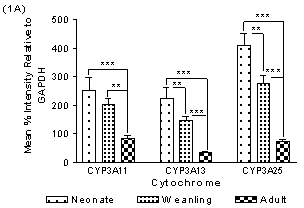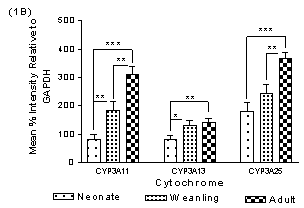| pA2 online © Copyright 2004 The British Pharmacological Society |
133P
University of Newcastle Winter Meeting December 2004 |
Gender and age dependent mrna expression of CYP3A isoforms in the C57BL/6 mouse strain M.J. Down & J.J. Mills. (S. Arkle). Department of Pharmacology, School |
|
The p53+/- mouse is being used as a more sensitive in vivo model for carcinogenicity testing, however little is known about the metabolic capacity of this strain. The metabolic profile of p53+/- mice and their wild-type counterparts (C57BL/6 mice) has been shown to differ significantly when exposed to hormonal carcinogens (Carmichael et al., 2001). We have therefore determined the mRNA expression of cytochrome P450 3A (CYP3A) isoforms in the livers of male and female C57BL/6 mice of 3 age groups, to enable future comparison with p53+/- mice.
The livers of male and female neonatal (4 days old), weanling (25 days old) and adult (136-149 days old) C57BL/6 mice were removed, snap-frozen in liquid nitrogen and stored at -80 °C. Reverse transcription was performed using Moloney Murine Leukemia Virus (M-MLV) reverse transcriptase and 2 µg of RNA isolated using the GenElute Mammalian Total RNA kit. 2 µl of each cDNA was subjected to PCR in a 50µl reaction containing forward and reverse primers for CYP3A11, CYP3A13, CYP3A25 and GAPDH. PCR amplification consisted of 25 cycles of 94 °C/30s, 60 °C/30s and 72 °C/1min followed by 72 °C/5min. PCR products were separated by gel electrophoresis (2% agarose gel/ 1XTBE/ 125V/ 30min) and visualised by ethidium bromide fluorescence. Bands were quantified using Syngene software and normalised to GAPDH (internal control).
A significant interaction occurs between gender and age in C57BL/6 mice (P<0.0001 Two-Way-ANOVA). CYP3A11, CYP3A13 and CYP3A25 mRNA expression decreases significantly in male (fig.1A) but increases significantly in female C57BL/6 mice (fig.1B) with increasing age. Direct comparison between males and females revealed a significant difference in the mRNA expression of all 3 CYP3A isoforms in adult and neonatal but not weanling mice (Two-Way-ANOVA).


Fig 1. Expression of CYP3A11, CYP3A13 and CYP3A25 mRNA in male (1A) and female (1B) neonatal, weanling and adult C57BL/6 mice. Data represent mean % intensity relative to GAPDH +s.e.mean. *P<0.05, **P<0.01, ***P<0.001 (Two-Way-ANOVA).
In conclusion, expression of CYP3A11, CYP3A13 and CYP3A25 mRNA in C57BL/6 mice is gender and age dependent. Future work will analyse CYP3A mRNA in p53+/- mice to reveal whether genetic manipulation to create this strain alters CYP expression.
Carmichael, P.L et al., (2001). Toxicol. Pathol. 29 (Suppl),155-160.